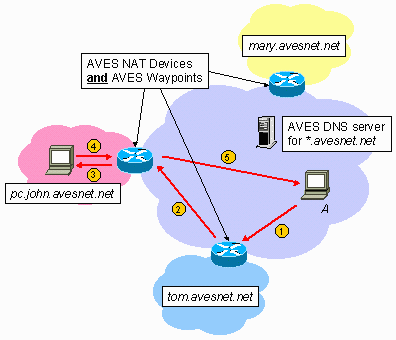
| Global Peer-to-Peer Deployment |
In AVES, the most critical resources are (1) the waypoint IP addresses, (2) the waypoint CPU cycles, and (3) the waypoint network access bandwidth. In our discussion so far, these critical resources are assumed to be solely provided by an AVES service provider and are shared among AVES users. This service model simplifies the deployment process. Unfortunately, as the number of AVES users increase, the demand on these resources will become heavier as well. Ultimately, the number of AVES users such a system can support will be limited by these resource constraints.
The key to achieve scalability is to have each AVES user contributes a small amount of these critical resources to the global system in a peer-to-peer community fashion. Observe that AVES users own NAT gateway devices, each of which possesses the critical resources needed in a waypoint, i.e., an IP address, some CPU cycles, and some network access bandwidth. Therefore, it is feasible to support the waypoint functionalities on the NAT gateways of AVES users. In other words, AVES users may help each other to achieve bi-directional connectivity by contributing to the pool of waypoints and sharing their resources. This way, as the number of AVES users increases, the amount of waypoint resources in the system correspondingly increase, ensuring scalability.

The figure above illustrates the peer-to-peer deployment model of AVES. Comparing it to the figures in the How Does AVES Work? section, notice that the service provider's dedicated waypoints are eliminated. Instead, each AVES user's NAT gateway device is now a waypoint in the system. The AVES service provider still provides the host naming functionality and the control path coordination, but the data path resources are completely contributed by the AVES users themselves. In our simple example, there are three AVES users shown, John, Mary, and Tom, and we show how Internet host A connects to host pc.john.avesnet.net that is behind NAT by sending traffic through the waypoint contributed by Tom.
There are many additional challenges that need to be addressed before peer-to-peer deployment of AVES can become a reality, they are summarized below:
We are currently working to deploy AVES in a peer-to-peer fashion. With this approach, we will be able to allow individuals not affiliated with CMU to enjoy the benefits of AVES.